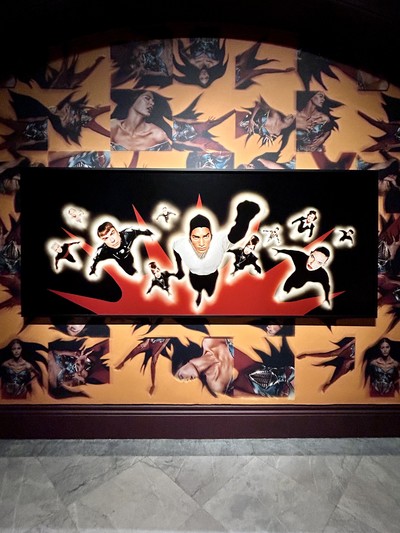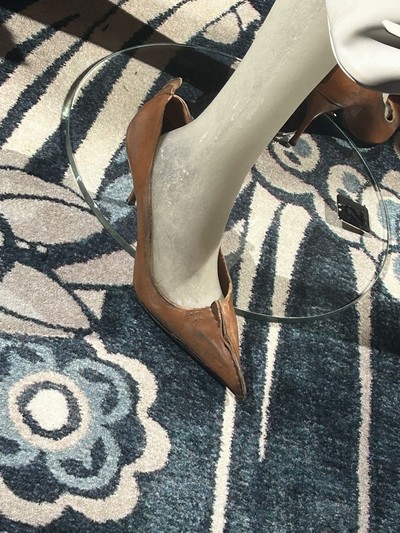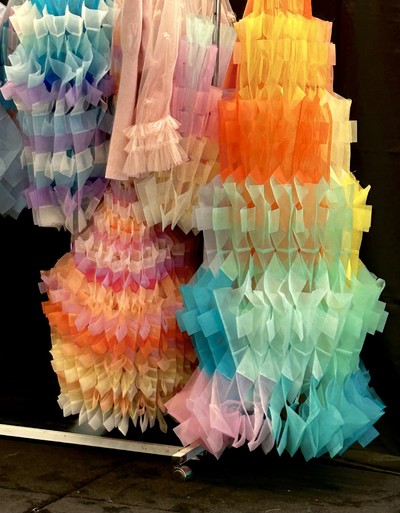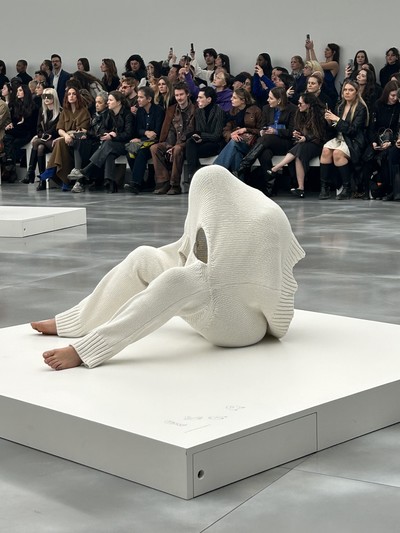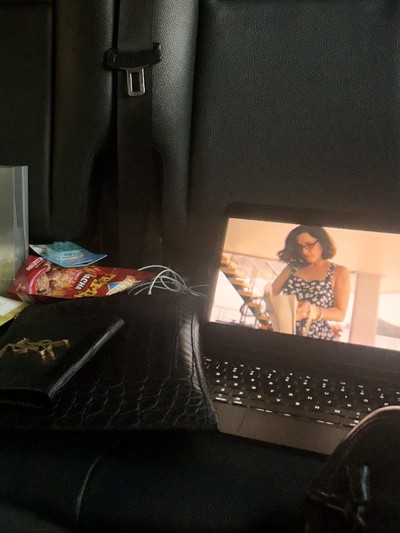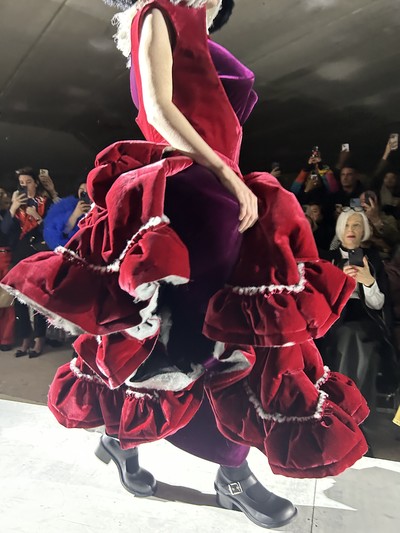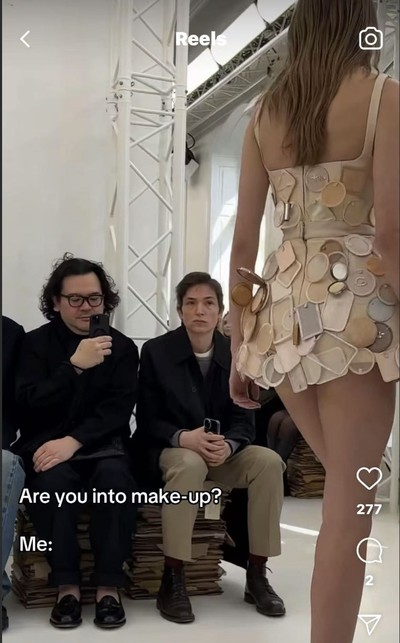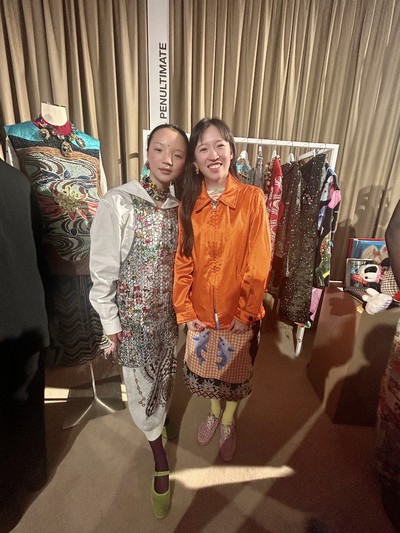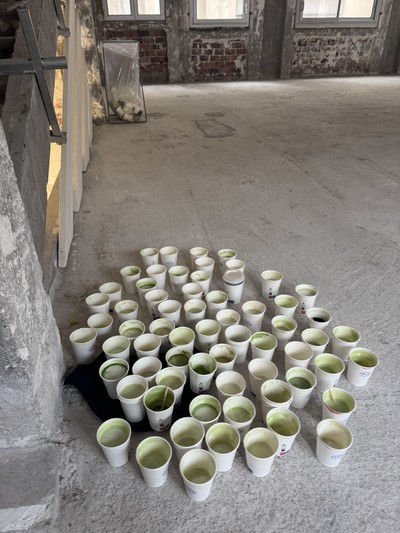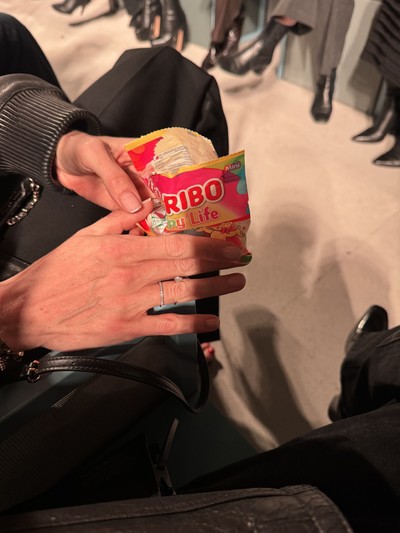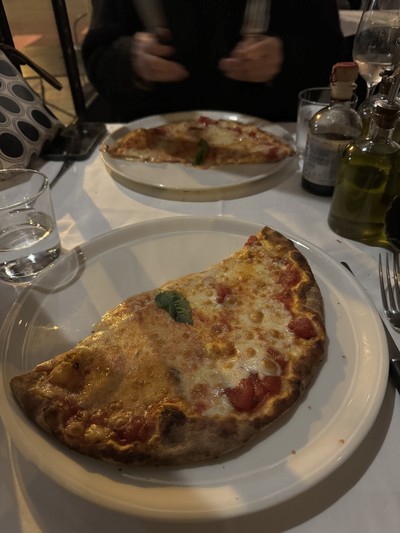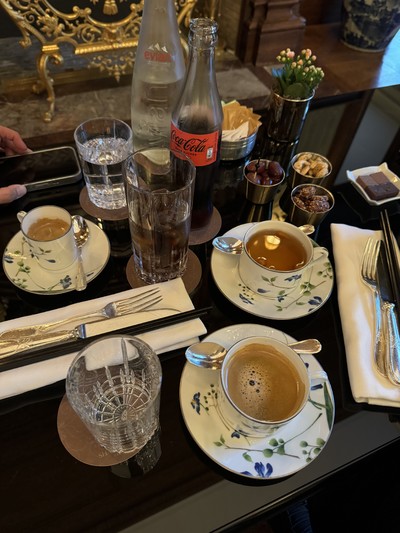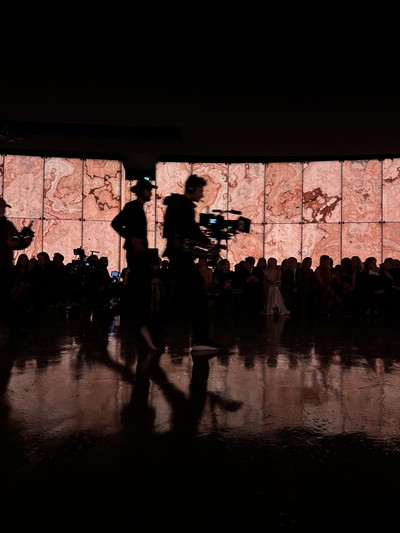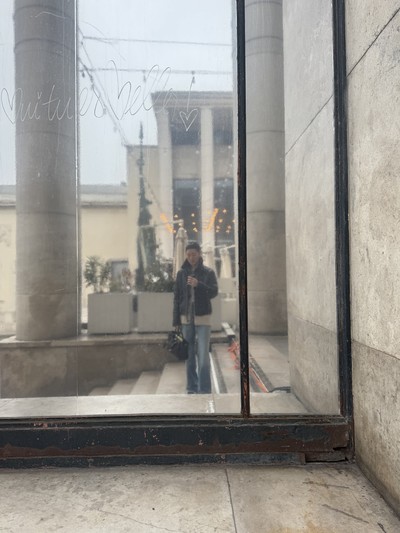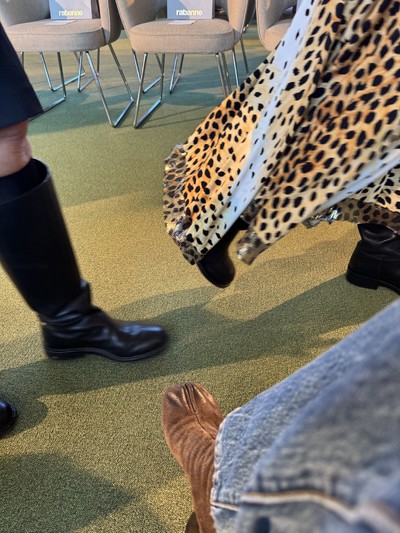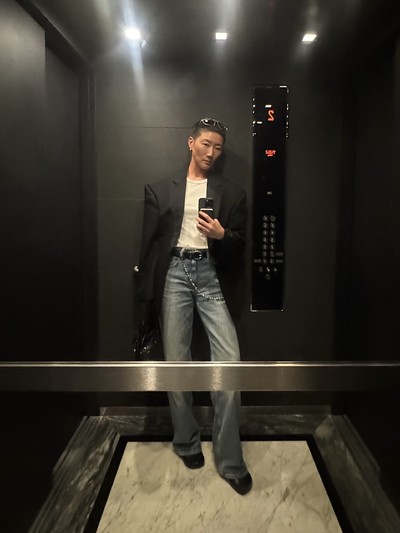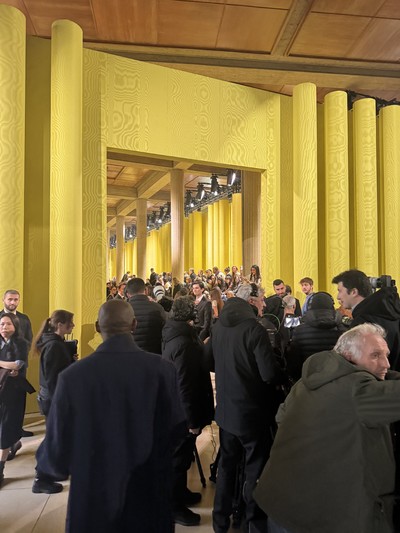Interview by Jonathan Wingfield
‘The megabrands remain very present in Asia. What’s surprising though is that it’s Gen Z twentysomethings who want Hermès bags, and who are wearing total look Chanel. Five years ago they’d have been wearing head-to-toe Balenciaga.There’s been a big shift, and a lot of that is driven by celebrity – Jennie has had a huge impact on this younger generation of Chanel fans.’
Tim Lim moved from Toronto to Hong Kong in the late 1990s, landing the position of fashion editor at the South China Morning Post at the tender age of 23. In 2006, he joined Modern Media (renamed Meta Media in 2022), and has since held the role of group fashion director, overseeing all titles and platforms, while also serving as editorial director of Numéro China and Modern Weekly Style Magazine. Leslie Sun is head of editorial content at Vogue Taiwan and Vogue’s Asia-Pacific (APAC) editorial director – comprising the Japan, India and Taiwan markets. Born in LA, but raised in Taipei, she cut her teeth designing exhibition catalogues and artist monographs for museums and galleries in the US before returning to Taiwan in 2012. Today, Lim and Sun oversee major publications in China and the Asia-Pacific region respectively – huge geographical locations with widely varying readerships. System sat down with Leslie and Tim the day after the Paris shows had ended to discuss how Asian perceptions of Western luxury fashion – and indeed, how Western perceptions of Asian media and consumers – have changed over the years, how fashion can be used to cross cultural boundaries and, of course, their highlights from the Autumn/Winter 2025 season collections.
Jonathan Wingfield: Tim, you’ve been attending shows in Europe for many seasons. Could you paint a picture of how it was to be a member of the Asian press when you began coming, and how that experience has evolved over the years?
Tim Lim: Back when I started, Asia basically meant Japan. I’d receive invitations addressed to ‘Tim Lim, South China Morning Post, Japan’ – on more than one occasion!
Leslie Sun: This is the early 2000s, right?
Tim: Yes. By the early 2000s, the bigger brands had become more familiar with the Asian press, but overall, there was still a lack of awareness. Hong Kong was slightly more on the radar because it was home to a lot of regional headquarters, yet there was this sense that the industry wasn’t truly interested in our part of the world – certainly not in the mainland Chinese media. People would say things back then that would absolutely get them flattened today. That started to change around the time Vogue China launched in 2005. There was real momentum building, and the market was clearly growing.
I remember there being a lot of anticipation in Europe around the launch of Vogue China. It was a big deal.
Tim: When I think back to that time, the momentum and the need to deliver something at a certain level – along with expectations about what the magazine would mean in the market – meant the bar was raised. But the reality of the situation at that time was that the mainland China industry was in its earliest phases. There weren’t the talents to produce the magazine. So the industry accelerated very quickly after that. Especially within the last 10 years, we’ve reached a point where we now have a confident creative community and wider media industry that’s asserting itself more and, of course, the world is more aware, interested and conscious of what’s happening in this part of the world – not just in mainland China. There’s a growing Asian confidence, a regional assertiveness, that is exciting. More dialogue is happening on equal footing with the West.
What was the appetite of your readership like when you were starting?
Tim: Mainland Chinese audiences always liked to see Chinese or Asian faces. That was the difference for me, because in Hong Kong or Singapore or Japan at the time, that was not the case. So already in mainland China, people were interested in the representation of their own culture, their own personalities. At the same time, they were also quite interested in the outside world: actors, artists, singers. There was more curiosity. The West represented modernity and there was this impulse in China to be modern and engaged with the wider world. But that interest has declined over the past five years. People are now much more inward-looking, focusing on figures from their own pop cultural landscape.
Leslie: Also understanding how rich their culture is. I remember when I was living in LA, and this was the 2000s or the 2010s, people would ask, ‘Where are you from?’ When I’d say Taiwan, they would ask, ‘Oh, as in Thailand?’ I’d get that all the time! I feel like Taiwanese people take a lot of pride when they are being seen and recognized by the rest of the world. I might sound too obnoxious saying this, but I kind of knew that the Vogue Taiwan formula I put in place would work – to showcase the landscape, to showcase the talent and to have the world talking about us. It quickly became successful. Even if it’s just a tiny aspect of Taiwan being displayed on this public platform, to our audience it is really gratifying.
‘Back in the early 2000s, Asia basically meant Japan. I’d receive show invitations addressed to ‘Tim Lim, South China Morning Post, Japan.’’
In what ways did you look to make Vogue Taiwan more compelling to both local and global audiences?
Leslie: Considering the Taiwanese market, we don’t have a robust fashion industry. Everything is foreign in terms of fashion. The closest would have been Japan back in the day, now it’s Korea, and everything else is coming from the West. When most fashion is coming from the West, it’s not so much about a creative relationship – it’s more transactional. So how can we make it more compelling to the public, rather than just a cover that looks like another commercial with a celebrity on it? That’s why I decided to use storytelling to attract those who may not be completely interested in fashion. At Vogue, we’re supposed to see everything through the lens of fashion, but with Taiwan, specifically, it sometimes has to be fashion through the lens of culture or current events. To capture the audience’s eyeballs first and then get them into fashion. There’s fewer people we can capture with fashion alone. Edward [Enninful] did that beautifully at British Vogue, to be able to talk about activism and so on, but not lose that Vogue DNA.
It always felt fashion.
Leslie: Exactly. I had the pleasure to get to know Edward and the way that he thinks and works. So I took inspiration from what was happening in his mind to figure out how I could apply that to my local market. The most successful cover we’ve had to date was January 2022. It was actually two covers: one with the model in contaminated water – it was not a set, the water was literally contaminated, although obviously not deadly. She was photographed rather like a mermaid, but in a Gucci dress. That created a lot of impact because of how much that single image was able to say. Then it was accompanied by a second cover with no fashion credits, where she’s holding a popsicle up to her mouth. The popsicle was actually a piece of work by an art collective who took polluted water from sewers in Taiwan and made them into popsicles. Then they used resin to replicate the popsicles. So the messaging is, ‘OK, if we’re going to continue doing what we’re doing now, in the future the popsicle that you’re eating is going to be trash.’ It’s a very straightforward message, but because of the way the image was presented it garnered a lot of conversation globally. That was when we were like, ‘Wow, OK, that’s the power of imagery, and this is actually something we’re good at, too.’
It transcended the fashion readership.
Leslie: Exactly. People started paying attention to Vogue Taiwan. That was the first goal of the trajectory: to have people pay attention to Taiwan. And then we talk about fashion.
What about for you and the titles you oversee, Tim?
Tim: Both Numéro China and Modern Weekly approach fashion through an arts and culture lens. It’s our DNA and we started working with artists early on. One of the first collaborations, I think, was with Cao Fei – I dressed her avatar, China Tracy, in Hussein Chalayan for a shoot in Second Life. Those images ended up in Italian Vogue, and from there, we kept going, bringing in artists like Wolfgang Tillmans, Yang Fudong, Ryan Trecartin, and Ren Hang. One of Numéro China’s most successful covers was the one we did with Katerina Jebb – she created a full-body scan of the actress Zhou Xun in Chanel couture. What’s amazing is that we’re a mainstream Chinese media group with a very broad readership. I doubt that our peers in the most developed markets could have gotten away with what we were doing at the time. This speaks not only to our curiosity and daring but also to the hunger of the Chinese audience for bold new ideas. The situation has evolved, of course, but I think that’s still true today. Chinese audiences are now incredibly fashion- and media-fluent, and they have very high expectations when it comes to covers and content. You constantly have to push further and surprise them with every issue.
Would you say that the growth of art and fashion have gone hand in hand in China?
Tim: Yes, I think that’s quite accurate. We were speaking to a cultural elite that felt slightly apologetic about loving fashion, and back in the early 2000s, fashion wasn’t the medium in which mainland China excelled. We didn’t have many great designers or photographers, but what we did have was a vibrant and groundbreaking art scene. These two fields would often intersect and amplify each other in a way that was very aspirational to an audience that might otherwise have been reluctant to embrace fashion full-on. Now, of course, they are very much entwined.
Has the rise of social media triggered a desire for younger people to want to become photographers, stylists, make-up artists… to want to engage with fashion professionally?
Tim: When Vogue China launched, there were only really one or two fashion photographers, but now you have an entire new generation that is fluent in the vernacular of fashion. In many cases, they are coming back from abroad, having studied in the States or in London. They have that knowledge, but also want to create a new visual language that’s closer to Chinese culture.
Leslie: In Taiwan, not so much. It’s been an ongoing issue for us in terms of visual talent. Not to get really political, but the Taiwan–mainland situation isn’t helping us at all. We would have a huge pool of talent to work with, if not for the political situation. Chinese talent cannot come to Taiwan. Sometimes they don’t want to be associated with us. Excluding China, it’s not easy to find talent that has a strong point of view, and when someone with real singular talent does emerge, they quickly end up shooting for everyone.
For Western photographers and stylists, there is so much that precedes them. It’s almost impossible not to be influenced by the medium’s canon – Avedon, Newton, Guy Bourdin, David Sims, Juergen Teller… Are those the same mainstay references for younger Asian image makers, or would you say refreshing and alternative aesthetics can emerge because they don’t have that canonical reference point?
Leslie: In terms of photographers, I’d say both. Sometimes you find those who are just originals. You know what references they’re using but they are able to twist that into something deeply personal. Then there is the other type of visual talent, who take references but do them really beautifully, which feels almost more about the craft. They’re referencing something from Viviane Sassen, but they do it exquisitely. I don’t want to speak for stylists in Taiwan, because I think it’s a bit unfair. They work with very limited resources. The samples that are available to the APAC markets – excluding China and Japan, but for Asia-Pacific – we get things late; we don’t get as many samples. There’s not as much to work with for them. The brands then want full looks and there’s not a lot to play with.
Tim: We have access to more resources in mainland China. In fact, the biggest challenge can sometimes be having too much at your disposal – you can become a victim of your own success. Take a singular talent, a photographer or a stylist, and as Leslie says, the minute someone is good, these talents are quickly snapped up – not just by the market and the brands, but by the media. There’s a lot of opportunity in our market and Chinese brands and titles like to work with local talent. They can become successful very quickly, and then they have to become many different things to many different people and that singularity is somewhat diluted. But then again, if I were a 25-year-old photographer and someone was throwing all of these opportunities at me – all these celebrities, all of this money – would I be strong enough to say no? So there’s less time for them to mature.
Leslie: To refine their craft.
Tim: That’s also our fault as editors, I would say.
‘When Vogue China launched in 2005, there were only one or two fashion photographers; now there’s an entire generation fluent in the fashion vernacular.’
What do you consider the best of Chinese fashion design at the moment?
Tim: A lot of our young designers are now on an equal footing with the best young international designers in New York, London or Paris. The question I’m asked most is: ‘Who is the Yohji [Yamamoto] or the Rei Kawakubo of China?’ Of course, these people do not come along every day; I don’t know that we’ve really found that ‘one’. There are certainly talents though, and we’re seeing them on an international platform. There’s Uma Wang, obviously, very established. Shushu/Tong. And also finding an audience overseas, we have Robert Wun from Hong Kong. We have Windowsen and Bad Binch Tongtong who are finding interesting ways to work through celebrities. We have Penultimate, a finalist for the most recent LVMH Prize. Then there’s Rui, Ruohan and Dido [Liu].
Is the ambition for these young designers to grow their brand and to have a real presence across mainland China? Or do they dream of becoming, say, the next creative director of Balenciaga?
Tim: It was interesting watching that latest Kawakubo show where she said, ‘smaller is stronger’. This younger generation isn’t necessarily looking to scale, they’re trying to do something that’s very specific and personal. There are, of course, those who are more ambitious, whose sights are international. But a lot of the new generation want to do something that is more craft-based and meaningful to them and speaks to their home market.
Leslie: To be completely honest, in terms of Taiwanese designers, there are only a handful who have made it outside of Taiwan. Not in the past two years, but in the past two decades! Our government is really trying to support the fashion industry, but that is also a downside because designers become complacent as they’re always getting government funding. They’re like, ‘Oh, well, I have a platform anyway. I get to show a collection. I have government support.’ There’s just no growth because designers don’t feel the need to grow. Those who have made it overseas, or made a name for themselves, don’t want to associate themselves with the Taipei fashion scene. They’re like, ‘We’re the ones really working hard trying to make it and these people are just swimming in the fish bowl.’ So we’re launching a fashion fund in Taiwan to try to create more competition in the market – we’re trying to strike a balance and target those who are serious about building a career. The fund is attached to Vogue Taiwan, officially named the ‘Vogue Taiwan Fashion Fund’. Vogue-owned and operated markets are trying to align our fashion funds as much as we can globally, so the application requirements and structure for Taiwan is based on referencing existing ones in the US, UK, and China.
Tim: Uma Wang won Modern Media’s inaugural fashion prize back in 2006, and we have been growing with and celebrating the best of Chinese design ever since. We do this editorially through Numéro’s annual Talent Call and design awards across the group, but also in daily ways by connecting designers with brands and manufacturers, and also artists, photographers, and stylists with their peers overseas. That is really the most exciting part of my job – bringing together a diverse, like-valued community of creators and giving them the space to do their best work. And it is something that Meta Media prioritises through its relationships with different cultural institutions and fairs to bring Chinese talents to the rest of the world. We just curated a survey of Chinese fashion photography from the last 30 years to tie in with a show that we organised with the V&A in Beijing. And an ongoing project documenting the life of Madame Song – the late Chinese style icon, Pierre Cardin muse and cultural catalyst – was featured in the first major exhibition of her legacy at M+ in Hong Kong. So a big part of what we do is inspiring the next generation of creators – by bringing context and depth to fashion, and by holding up new role models.
Would you say ‘niche’ in mainland China still represents enormity when it comes to actual numbers? Compared to, say, a niche title based in Europe?
Tim: It’s certainly growing, but the numbers are not exponential. I mean, I could talk publication figures, but I don’t know how insightful that would be. Subculture is less pronounced in mainland China. Of course, there’s a lot of different of lifestyles, interests, and regional or local experiences. But subculture, as expressed in the style media, isn’t nearly as articulated as it is in the West. It’s harder to speak to niche groups in that way.
Where is your readership geographically – in Shanghai and Beijing, or also in the other regions?
Tim: It’s always been more of the first-tier cities with print, but now that things are digital, they reach everywhere. We’re seeing different cities grow in influence and assert their own identities. Chengdu is a strong fashion capital and we have Xiamen in Fujian, which has been called ‘the Antwerp of China’. Of course, Beijing and Shanghai dominate, but it can go anywhere: on social media, you have kids in the Chinese countryside fashioning runway looks out of refuse.
‘Of course, Beijing and Shanghai dominate, but on social media, you’ve got kids in the Chinese countryside fashioning runway looks out of refuse.’
When did you first notice that fashion’s reach was really spreading?
Tim: Around 2018 it had reached a boiling point and this trend of guochao, or ‘national wave,’ really started gaining momentum. The conversation around fashion began to shift – it moved beyond the usual status symbols and big Western brands and began reaching a much broader audience. For instance, the sportswear brand Li-Ning had its first fashion show in New York at that time, incorporating a lot of nostalgic Chinese iconography, and it went viral. Suddenly, it became cool to be Made in China, to embrace traditional dress, and to explore socialist aesthetics – not just in fashion, but in architecture, graphic design, beauty and travel. That moment coincided with a new cultural confidence and assertiveness which only grew during the pandemic. It culminated in the rise of the Gen Z hashtag #xinzhongshi, or ‘new Chinese style,’ which exploded on the social media platform RedNote [Xiaohongshu]. As a trend, it’s probably played out by now, but there’s still this deeper desire among many Chinese creatives to redefine and reconstitute what Chinese elegance and identity mean. Designers like Samuel Guì Yang, Ms Min, and Yueqi Qi are doing this in nuanced and very personal ways, as are photographers like Leslie Zhang, Luo Yang, and Feng Li. That is a much bigger project.
Leslie, the fact that you work across such vastly different regions – you have Vogue in India, Japan and Taiwan under your editorial remit – when you come and see the shows, how do you try to view them for each market?
Leslie: I am focused on quality control: ensuring visuals meet high standards, storytelling and content aligns with the Vogue brand, and supporting the local teams. When it really comes down to knowing the market, we have heads of content for each individual market. So Tiffany [Godoy] and Rochelle [Pinto] would be the experts for Japan and India.3 We are such distinct markets that I would literally be bipolar if I was going to know what would work for each market.
Tim: Tripolar!
Leslie: [Laughs] I mean, there are times where it is specific, like, ‘I have a feeling this is going to work really well in Japan.’ But more so, I look to that bigger scope of messaging: what is this season trying to say? What is this collection trying to say? We’ll get together as a collective and we discuss the collections, and we brainstorm the global stories that we are going to produce that will speak to everyone. Not to say that one size fits all. It does not, but there are still certain tidbits of messaging that could work for everyone. When it comes down to details, if someone’s doing down puffer jackets, it’s not going to work for India because of their climate. But then we ask ourselves, what does Vogue offer? A bit of fantasy, right? Plus, people travel, they go skiing. Once we all collectively agree on the messaging that we’re going to send globally with those stories, we’ll then go and tend to our local markets – either in the way we shoot the cover, or the way we do features or cover certain designers. We’ve reached a point where we no longer try to force similarities between the Taiwanese, Japanese, and Indian markets. There’s much more in common between Taiwan and Japan than with India, but there’s a large Indian diaspora in Singapore and the Middle East. This has been a learning process – understanding the cultural nuances and allowing connections to develop organically.
Do you find there are particular brands or designers that perform disproportionately better in one market over another?
Leslie: India is an evolving market, which is something I’ve only really discovered since stepping into this role. Despite the massive population, it’s still considered a small market for luxury. It’s a growing market for luxury and a lot of the brands are homegrown; they have their own ecosystem going on, it’s a bit like Bollywood. There’s actually a degree of difficulty to convince them to buy Chanel when they have their own version of high to low.
There’s a maturity to the market.
Leslie: Exactly, it’s actually quite robust. Similarly in Japan, but culturally they gravitate a lot more towards what’s happening in the West. But the way that Asian figures tend to be built, certain things would look good on us and certain things less so. So that also helps decide which brands are more popular. The megas: the Hermèses and the Chanels and the Vuittons are definitely still doing really well in Asia. In Taiwan, specifically, we are in the top five for watches and fine jewellery consumption. We have a tiny population but very deep pockets and a lot of these high spenders are extremely low-key. So Loro Piana is doing so well in Taiwan, even before the whole ‘quiet luxury’ trend. Same for Brunello Cucinelli, and obviously Hermès.
Is that a characteristics thing?
Leslie: I think it’s cultural. We’re known to have very sophisticated buyers and very loyal consumers. Once you hook them with that story, then they’re yours – which means brand story and heritage are fundamental for the Taiwanese audience. I tell the brands whenever I can: Taiwan is actually far more similar to Southeast Asia – in taste, in the ways that we receive communications and consume – than to China and Hong Kong.
Is that a surprise for the brands?
Leslie: Yes!
Tim: I mean, Taiwan has always had very strong brand attachment, certainly within the watches and fine jewellery markets. Whereas mainland China has been a lot more promiscuous in terms of brand loyalty and taste.
‘The idea of the sexualized 1970s Halston woman won’t necessarily translate. Women from certain parts of Asia don’t express their sexuality that way.’
Tim, can you tell me about some of the brands that have a real presence across mainland China?
Tim: The megabrands remain very present. What’s surprising to me is that it’s Gen Z that are still very much into these brands. With Hermès and Chanel, it’s twentysomethings who want those bags and those hairbands, and who are wearing total look Chanel. Whereas five years ago they might have really liked Balenciaga. So there’s been a big shift, and a lot of that is driven by celebrity – Jennie [Kim], for instance, has had a huge impact on this younger generation of Chanel fans. Also, because the market is troubled, people are more reluctant to spend. And when they are spending, they’re looking for things that are more investment-based or are signifiers of a certain level of taste. You’ll have young editors searching second-hand online platforms for vintage Hermès – but Margiela Hermès. For years now, we’ve also seen huge interest in The Row on platforms like RedNote. These might seem counterintuitive to the more ostentatious idea of a Chinese fashion customer but they’ve taken hold quite quickly. Beyond that, because China is often very trend-driven, brands like Miu Miu are very popular.
Do you think that could shift quickly if a new, very strong fashion vision comes along, like what Alessandro Michele brought to Gucci?
Tim: Definitely. That’s a good example. It’s both exciting and slightly terrifying at the same time. There’s so much possibility and it makes my job very dynamic.
Generally speaking, how do Asian customers and audiences relate to the cultural references that Western designers often embed in their collections? Say, for example, Saint Laurent referencing an early 2000s Hollywood movie like American Psycho, or the photography of Helmut Newton. Or when a brand is said to be referencing Tom Ford-era Gucci. Are Asian customers and audiences finely attuned to these references?
Tim: You’d first need to distinguish between mainland China and then Taiwan or Hong Kong, which have a longer history of both fashion – with pioneers like Joyce Ma who lived through the late 1960s,1970s and 1980s – and, of course, the film and entertainment industries. People there would more likely understand a 1970s or a high-1980s reference. In mainland China, it’s different. The fashion culture is much younger so we, as editors, need to familiarize people with those references. A good example is something like Chemena [Kamali]’s Chloé. It’s not the distant past, it’s 2000s boho chic, but it wouldn’t be part of the collective consciousness of mainland China. People would access it from a different point of entry, either through our storytelling or by seeking out the references which are now much easier to find online. Or simply by viewing it through completely new eyes and just seeing it as a proposition that feels relevant. Some references might be more challenging or might need to be adapted; like how the idea of a sexualized 1970s Halston woman won’t necessarily translate in the same way. That may not be how women from certain parts of Asia would express their sexuality.
Does that create a sense of disconnect?
Tim: Maybe. They might just not engage with it, or they might find their own way to it. This is the wonderful thing about fashion: you adapt and take what you want from it. You might end up coming across something in the hair or make-up, or it might be the spirit of something that is appealing.
Leslie: There are certain cultural aspects from the West that are totally relevant or popular in Asia, while some are really farfetched. If people can’t relate too much, then it becomes a spectacle. Not to say that spectacles don’t sell – it could still strike up a conversation, but it’s not really up to us to generate that kind of storytelling. For example, with the Saint Laurent collection, people don’t really understand the Michelle Pfeiffer Hollywood aspect of it, but then if we say 1980s power dressing, or suiting, it becomes compelling to our audiences. In the West, people just know it’s American Psycho, but in Asia they generally won’t. As Tim said, because of the Internet and the rise of social media, people can easily find out what it is, if they want to.
Are there relatively obscure Western references which are becoming popularized in mainland China via fashion’s ubiquitous presence on social media?
Leslie: You mean like Uggs? [Laughs]
For example, Anthony Vaccarello might do a Saint Laurent collection inspired by Betty Catroux. When presenting her to a market where she is completely unknown, I’m curious to know if she could become a cult fashion figure on Asian social media.
Tim: Because of the curiosity that I told you about, within the mainland, this kind of storytelling is quite common on WeChat. People are going quite deep to construct not only Western fashion history but also their own history, because so much of it has not been documented. Modern Weekly has started a series of oral histories, in print and on podcasts, to capture the key moments in China’s modern fashion history. The industry has evolved so quickly that there hasn’t really been time to pause and reflect – let alone remember those chance encounters, seized opportunities, and connections that brought us to where we are now. A great example is Alber Elbaz’s first show in Shanghai, in 2002, just months after his debut at Lanvin in Paris. I remember it well because it was the first time I did a shoot on the mainland, and it was also the first time one of China’s early power brokers, [fashion PR guru] Melvin Chua, worked with Alber. That collaboration sparked a lifelong friendship that was catalytic: Alber immediately commissioned Chinese artist Liu Jianhua for a global Lanvin campaign and brought a group of Chinese models to Paris for his next show – both things we take for granted today. It was a major turning point – just like the Fendi show on the Great Wall or Yang Fudong’s iconic Prada campaign – but there was virtually no record of the show ever taking place.
Leslie: I think there’s a difference between Taiwan and mainland China. In China there is a massive population of young people who are genuinely curious, and who go really, really deep into the stories, the heritage, the history of fashion. I feel like that level of sophistication or curiosity for Taiwan happened with the older generation – before the Internet existed. It was more a question of, ‘Oh, we’re the insiders, so we know this.’ Whereas now, with the younger generation, it’s more surface level compared to China. A lot of times I go on Xiaohongshu or WeChat and there would be these entire thesis papers on fashion history!
Tim: People definitely read.
Leslie: Those writers will spend the time to go and dig and do the research. Whereas in Taiwan, we as the media need to build these stories for the younger consumers.
‘If you go to Shanghai, or even Chengdu, people can be really daring; there’s gender fluidity, using both fashion and beauty as a means of expression.’
Tim, what part has fashion played in the shifting rapport with individualism in mainland China? Given that a few generations ago individualism through dress was not really an option.
Tim: I mean, it’s a human impulse to want to differentiate yourself. Culturally, of course, that varies. I would say that within mainland China it’s generational, but it’s also regional. China is so vast, there are so many different realities. Within those first-, second-, or third-tier cities, I think fashion has become one of the most important vehicles for expressing who you are. If you’ve been to Shanghai or Beijing and walked through the streets, youth culture exists like any other place – it’s very accentuated, because people kind of embrace a look. There’s a Balenciaga tribe, or there’s a streetwear tribe, or a hip-hop tribe. It’s more embedded or defined by sartorial signifiers than it is by a deep cultural connection to music or club culture. Unless we are talking about fan culture, which is less about individuality and more about different tribes distinguishing themselves from each other – followers of one idol versus the followers of another idol. They can be very distinct and combative in how they shop and express themselves, and as a group have a collective buying power that they don’t hesitate to flex.
Let’s talk about one of the most impactful fashion developments of the past 15 years: the rise of Asian models on the runway at Western shows, and the presence of Asian KOLs [key opinion leaders], influencers and celebrities on the front row.
Tim: Asian models have become normalized, absorbed into this system. It’s a general shift towards representation and it’s obviously a good thing.
Leslie: They’re just embedded now.
Tim: And there are increasingly broader expressions of what that looks like: not just Han Chinese, Korean or Japanese; you now have more Southeast Asian faces. And yes, in terms of the KOLs, there’s now a second or even third generation of influencers working with different platforms out there.
Can you remember who the first generation were? When that would have been and who it would have been?
Tim: On an international level, I remember I sat next to Tommy Ton at that pivotal Dolce & Gabbana show in Milan in 2010. But in terms of influencers coming out of Asia, I mean, who are the OGs?
G-Dragon out of Seoul?
Tim: Yes, I would say G-Dragon was probably one of the earliest ones, and Fan Bingbing out of China.
Leslie: In my memory, it was influencer culture, and then brands started to bring celebrities to shows to get more exposure, and then all of a sudden, it’s like – blink, and every fashion house has a K-pop ambassador.
Without sounding too cynical, there is undoubted influence but then there’s the purely transactional nature of the ROI associated with these kinds of ambassadors.
Tim: There’s a big question about this at the moment, because, of course, in good times it’s easy to bring in exposure.
Leslie: It’s one thing to bring eyeballs and a different thing to bring revenue.
You mean that brands are scrutinizing the value more?
Tim: Yes, definitely scrutinizing. It seems like they’re everywhere, but from my point of view, I’ve observed there are maybe less…
Leslie: I have a feeling too that this season – I mean, they’re still very much present, but slightly less.
Tim: The brands don’t have as much budget to bring them, for one.
You were also saying to me, Tim, there was far less Asian press present in Milan this last season.
Tim: In Milan, there’s a tradition of sponsorship, and that has been tightened.
What about Paris? Do you sense there is still a very robust presence in terms of Asian media?
Leslie: I mean, I only go to Paris. I should be going to Milan, but it’s similar with other members of the Asian press: if you don’t have the time bandwidth, you always prioritize Paris.
Turning our attention to the collections themselves: what stuck out from the Autumn/Winter 2025 shows?
Tim: There is this sense that we’re on the precipice of something, that we’re all waiting to see what that is – positive or negative, because I don’t know if it’s a given either way. But for me, the designers who stick out are those who are world-building and who have a very specific message. Just to name a few: what Pieter Mulier is doing at Alaïa, that was universally loved. You always go to Milan for Prada, and I think what Francesco [Risso] is doing at Marni is interesting, because, again, it’s a world. What we saw at Miu Miu or at Marni, there was this kind of oddball, idiosyncratic, [John] Waters-esque persona through the casting – they stood out. Everyone was a character – young, old, unknown, famous, vaguely familiar – and yet they all seemed native to the alternate realities the designers had conjured up for their collections. Who else stood out? Duran [Lantink]. Aside from the obvious titillation – excuse the pun! – it’s a specific language, and it was great to see him incorporate some new vocabulary this season, an element of perversity.
‘India is an evolving homegrown market. There’s a degree of difficulty in convincing them to buy Chanel as they already have their own versions.’
Is there an appetite for really expressive, outlandish clothing in mainland China?
Tim: There are certainly people who are fully living their truth in the bigger cities. If you go to Shanghai, or even Chengdu, people can be really daring; there’s gender fluidity and street pageantry, using both fashion and beauty as a means of expression. There’s often a discrepancy between what one reads about the level of freedom in mainland China and the lived reality of people in urban areas – which, of course, varies depending on where they are and their circumstances.
What about in Taiwan?
Leslie: We have a very laid back culture. There are not a lot of heavy dressing-up occasions, but there are people who like fashion in the sense of self expression. A lot of things I’m seeing this season are very wearable. There’s a twist or there’s some creativity in it, but it’s still contained. You’re seeing these nipple statements at Miu Miu but they still break it apart and do everyday wear with the jackets and so on. So they’re giving you maybe 30% of a statement, but 60% wearability, and then 10% whimsy. So the mix is very consumer-friendly, but also much more sophisticated. I personally am very happy to see that grown-up dressing is coming back. And tailoring.
‘Taiwan is in the global top five for watches and fine jewellery consumption. We may be a tiny population but we have very deep pockets.’
Everyone in Paris was talking about the state of the market and the sense of impending doom. Asia has been driving astronomical levels of growth over a sustained period of time. Brands of all sizes have gotten used to that, and there’s now an immediate sense of, ‘Well, that’s it. It’s over. It’s reached its peak. It will never perform in the same way.’ What’s your take on it all?
Tim: It’s not just the brands in the West that relied on this upward trajectory. Chinese people also took it for granted. It’s been quite jarring to the market and the industry, spurring a reluctance to spend. So, it is definitely real. We’ve had a number of economic challenges over the years, but I feel a greater shift this time.
Why do you think it has happened?
Tim: Globally, it’s messy. We came through Covid, and then because of the real-estate crash people are not confident. They don’t want to spend. There’s also been a shift with the younger generation aspiring to different ways of expressing themselves, looking more to experiences.
Would you say there’s a luxury fatigue?
Tim: I’d say there’s a consumption fatigue, to a certain extent. Obviously it’s a product of this moment. There’s this phenomenon of young people ‘lying flat’ in China, of disengaging from consumer society, rejecting the expectations of their parents in terms of them finding success.
As an act of rebellion?
Tim: It’s kind of a natural development. People realize there are other things that matter. The prospects for youth today, like everywhere in the world, are not the same as the opportunities their parents had. They’re looking in different directions for meaning – you know, there was a movement towards farming, or moving to rural areas. These are, of course, microtrends, but they’re real and they say something about the times, about the environment.
Does that weigh heavily on the kind of work that you’re doing?
Tim: As journalists, the shifts sometimes result in the most interesting stories or developments or solutions. We’re asking ourselves those questions as a platform. What sort of proposition do we want to make? What is the value we’re attaching to these brands, or this sort of storytelling, or how we want to approach consumption? Because we’ve never really been about ‘Buy this, look rich, be cool.’ That’s never been how I’ve approached my job. It’s more about celebrating creation and showing how fashion can be a form of expression.
‘Interest in the West has declined. People from mainland China are now more inward-looking, focusing on figures from their own pop culture.’
Do you think the designers and the brands that have invested more time into genuinely understanding the nuance of the market will have more sustained success?
Tim: Yes, and I would say the same thing about the rest of the world. The more you know who you are, and the more specific your proposition is, the easier it is for you to find your market. Uma Wang, to give an example, just opened her first maison, and it’s a very clear and authentic reflection of her brand – and she definitely has her customer. Not everything has to be super scalable.
Leslie: To rewind a little bit, when I’m talking to brand PRs on this trip in particular, if we’re talking about the rest of Asia, it’s always a little more positive. Thailand is growing at an exponential pace. People are very curious about India, the Middle East, obviously. There are other markets that they feel like are quite promising in the rest of Asia. But to speak for Taiwan in particular, there’s that older generation who will stick to their Hermès and Chanel and Loro Piana, but there’s really a lot of individuality with the younger group of consumers. Brands like Acne Studios and Loewe and Bottega Veneta are doing really well in Taiwan. Our economy has been stable, relatively speaking. I mean, the top of the pyramid will still spend no matter what the economy looks like, right? And then the bigger you are, the more things fluctuate with the rest of the world. But because we are small, the turbulence isn’t really so heavy, so spending doesn’t fluctuate as much. At the same time, spending habits are more conservative. Consumers tend to speculate, and then when they feel like, ‘OK, something’s about to happen, things seem a bit unstable,’ it’s more, ‘OK, we’re going to spend money on the things that we know.’ The reason why Acne Studios does so well in Taipei is because it is a little more sophisticated than streetwear, but it’s also easily mixed and matched, and the price point is relatively friendlier than their counterparts. That really works for the younger generation who don’t want to look the same as everyone else. Loewe really caters to those who like the sophistication of good tailoring, of craft, but don’t want to be like their moms or dads or whatever. But then there’s still an element of artistry and storytelling.
That brings me to the idea of craftsmanship. Is the notion of ‘Made in Europe’ still as coveted in Asia as it was 10 or 20 years ago?
Leslie: The craftsmanship messaging is probably much more relatable in Japan. I want to say it’s relatable to some parts of China too, because of the cultural heritage. It’s definitely relatable in Taiwan and in India, of course. But because I don’t know how it’s being perceived in the West, I’m not sure if it’s similar or different, or if it’s in tune with the intended messaging. I do feel there is definitely added value when there is that idea of craftsmanship attached. If you don’t have an occasion to wear a couture gown, then it’s just about spectacle and storytelling. OK, I get it: you’re spending 5000 hours to make a skirt. That’s how well you can do it. That aspect of branding remains important – even if you’re not buying this couture skirt, everything else that you’re buying from the brand is supposedly the same standard.
Tim: Did you go to the Loewe exhibition?
Leslie: I did.
Tim: It was a very successful approach to how you show heritage, and how craftsmanship can be modern. I actually had a little preview with Nadège [Vanhee-Cybulski] before the Hermès show, and she said something that seems basic but it’s very true. For her, ‘heritage is today’. I think you really need to look at it that way, that it’s not something from the past. It’s something that you live with. It’s going to take on more meaning if you’re investing not just in a garment, but in a sense of self.
‘There’s this phenomenon in China of young people now ‘lying flat’: disengaging from consumer society and rejecting the expectations of their parents.’
Lastly, Leslie, how do you want Vogue Taiwan to be viewed on the global stage? Do you have a particular ambition?
Leslie: A market like Taiwan is so different in scale and capacity compared to mainland China, Japan or Korea. What I can do for the market is to offer more understanding on who we are as a culture. And when I explain my title, it’s not a one liner… There are so many nuances and reasons behind what each and every market does. It’s like if people saw the European markets and said, ‘Oh, well they’re all the same’, but they’re definitely not! It’s just so funny, I almost feel like Asia should not be a singular region. So my goal is to create more awareness and understanding of how different and diverse we are.
Do you think that nuance is lost on most people?
Leslie: There is a lot more awareness across the world. But I feel like it’s still very much bundled up like, ‘OK, so there’s Japan and Korea, and they’re a certain archetype, and then there’s greater China, and they’re a certain archetype. Then there’s Southeast Asia, they are a certain archetype.’ Not to forget that Australia is also part of Asia Pacific, you know! And India! Like, how diverse is Asia Pacific? How can you just say, ‘Oh, well, the APAC region…’
Tim: Especially in times like these with the shifting geopolitical landscape. Being based in China, it has always been about establishing dialogue and creating new axes of exchange. We use the language of fashion and creativity to find common ground and foster understanding – both on a broader scale and within my own creative community.
Do you think fashion has the ability to help make those changes whilst almost hiding in plain sight?
Tim: You know, there are many topics that we can’t address directly in our work, but it’s a great space for us to celebrate creation and diversity; to bring in different realities and different talents. It’s a privilege for us to be able to present other peoples’ views on the world. It’s not something that we should take for granted. It comes with a lot of responsibility.
Leslie: Asian consumers, and I’m speaking more so for Taiwan and the Southeast region, we are as curious about you in the West as you are about us. Not everything is readily available to us, perhaps because of the size of the market, but a lot of consumers will go on these online shopping platforms and do their research. They already know some parts of you before you even know that they know. We’re very welcoming and we’re very curious.
‘It wasn’t just the Western brands that relied on our market’s upward trajectory. Chinese people also took it for granted. It’s been jarring for the industry.’
Ideally, how would you want that cross-cultural dialogue to manifest itself?
Leslie: In exactly that – a dialogue. Not specifically, ‘Oh, you designers or brands have to spend some time in Taipei, and then you have to spend some time in Bangkok, and then you have to go to Jakarta,’ not like that. But to invest more in understanding the culture and finding ways to speak to us that is not one size fits all.
Tim: It’s the same discourse that’s happening in the West about being part of your own storytelling. I feel that brands are starting to listen more to their regional teams about what resonates in their markets and engages them emotionally – something that was not so much the case at headquarters before. We need a more equal footing, or at least a constructive dialogue. There has been more of that recently, and when it works, it really works. When it doesn’t, the repercussions are stronger, which I think motivates a lot of brands to act more carefully and responsibly.
Leslie: I mean, we can’t demand genuine interest from everyone.
Tim: There are people who are going to be interested in what we’re doing in our part of the world, and there are those who are not. I mean, that’s completely fine, I’m happy to engage with the people who are interested in engaging with me.
Leslie: I rephrase: I don’t expect anyone to be genuinely interested but when you are, it definitely adds value.
Tim: And it’s wonderful when that happens, it’s magic.
